Have you ever seen an Australian Shepherd? It is a beautiful dog with a distinct coat and an affectionate, goofy, and playful personality. Now imagine it being much smaller and actually fitting a home of any size. That’s right, I’m talking about Miniature Australian Shepherd.
You can stop your search for the best life companion – here it is! No matter your living circumstances, there will always be enough space for one Miniature Aussie!
These little fur balls will make your life full of joy, laughter, and pride. They will leave you speechless with their talents, and you will not be able to look away from those gorgeous, warm eyes.
Join us while we uncover more details about this unique breed!
Breed History
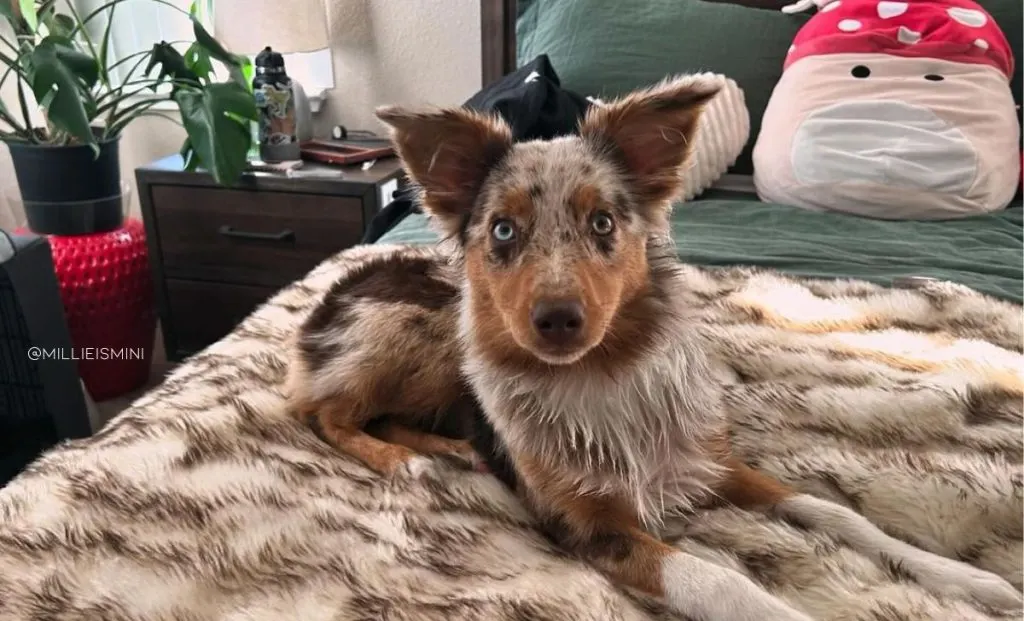
Miniature Australian Shepherd is a fairly new breed that was developed in California in late 1960’s.The goal was to maintain general characteristics of Australian Shepherd, but in a more compact size.
This would make the breed more suitable for the home as well as easier to travel with to the stock shows.
Since their origin is tightly bound to Australian Shepherd, we need to mention that their ancestors excelled in herding as well as in general work.
In the 1990’s Mini Aussies became very popular nationwide, so much that the Miniature Australian Shepherd Club of USA (MASCUSA) was formed and the breed managed to get the recognition from American Rare Breeds Association (ARBA).
Miniature Australian Shepherd was officially recognized by the American Kennel Club (AKC) in 1993.
Due to the complications that would arise when entering the same competition as the Australian Shepherd, the name ‘Miniature Australian Shepherd’ was changed to ‘North American Shepherd’.
If you think that is a mouthful, MASCUSA changed the breed’s name again to ‘North American Miniature Australian Shepherd’ so it would retain the connection to the Australian Shepherd’s legacy.
That is why you may find information about this breed under American Shepherd as well.
Physical Appearance
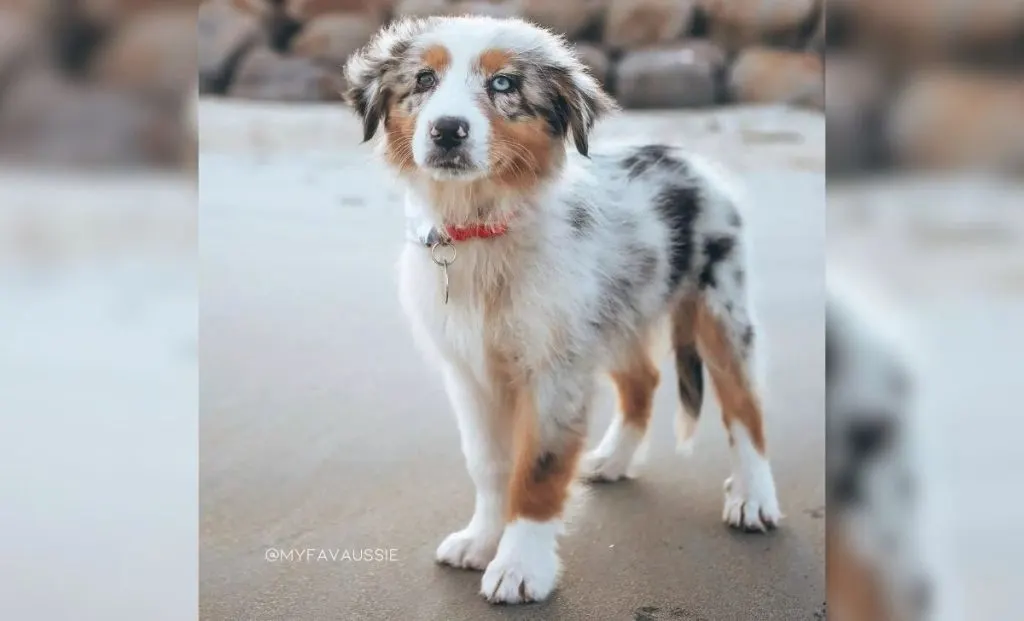
As it was intended, this breed resembles Australian Shepherd only in smaller size. Males grow 14 to 18 inches tall at the shoulder and the females follow with 13 to 17 inches tall. Average weight for this breed, regardless of the gender is 20 to 40 lbs.
They have a medium – length rough double coat. This interesting coat comes in different colors: black, blue merle, red and red merle. That’s right, these are the standard Australian Shepherd colors, as well.
Same as standard Aussies, Minis are born with short bobbed tails or you can choose to have them docked.
Fun fact: It is pretty common that this breed has heterochromia. This means they can have one eye blue and the other brown. How cool is that?!
Temperament
Despite their size, these dogs are excellent herding dogs: Energetic, tough and very intelligent. They are agile and have shown great results in dog sports. They are perfect dogs for herding sheep and smaller stock, but it is said that they get along with horses as well.
These amazing dogs are devoted to their family. They are caring, loving and affectionate, but due to the strong guardian instinct they can be reserved with strangers.
Mini Aussies are great with other dogs, very adaptable to the new environments and very playful. Overall they have a good temperament and if exercised daily, they will make great family members.
Grooming And Care
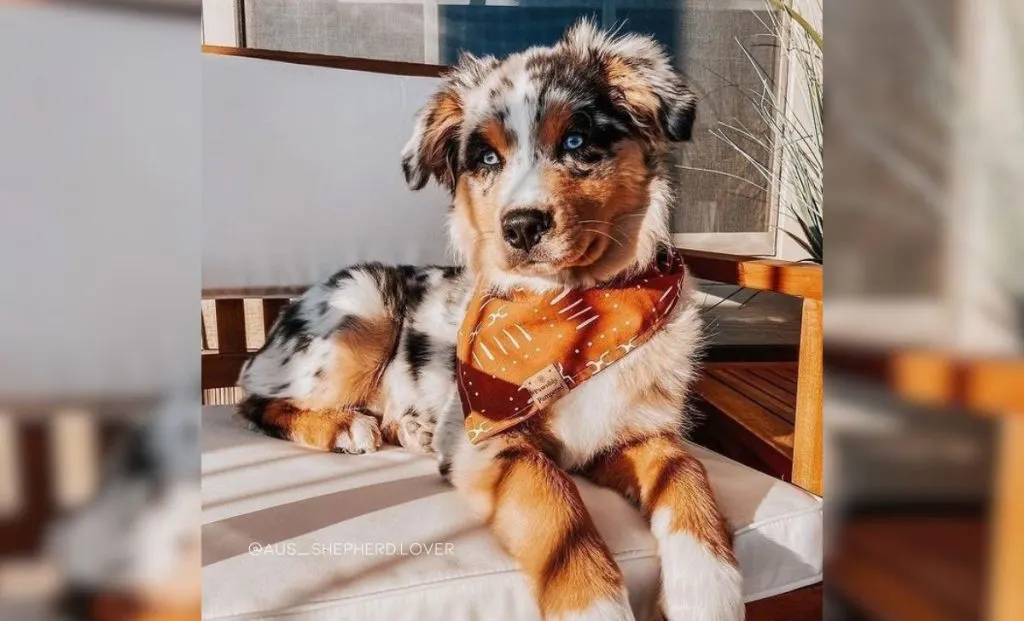
This miniature ball of fur has a double coat, with a longer outer coat and wooly undercoat. This breed sheds quite a lot, especially in a shedding season that occurs twice a year.
Weekly brushing (daily during the shedding season) can help remove the dirt and excess hair from their coat. A general suggestion is to use a slicker brush or a metal comb to work out the mats and tangles that may occur.
As with any dog breed, their nails should be trimmed regularly as the long nails can cause the dog discomfort.
Their fur must be trimmed occasionally, not only on the body but sometimes on the ears and head. Fur should be washed when dirty, but it doesn’t need to be washed too often. Their skin is not prone to rashes or skin conditions.
Floppy ears, no matter how small they are, must be cleaned regularly to prevent ear infections. We recommend using ear cleaner that has a drying component in it, especially after the bath or swimming.
Exercise
Similar to standard size Aussie, Miniature Australian Shepherds require much exercise.
They are very active, high energy, athletic, herding dogs that thrive when they are working. They are very adaptable, but they need those long runs so they can burn off that extra energy.
Besides their physical needs, they need a lot of mental simulation as well. Agility, obedience training and tracking can be a great way to stimulate this wonderful canine.
Even though they were initially bred for country lifestyle, they can do very well in the cities as long as their requirements for physical activity are met regularly.
These toy Aussies make great hiking and camping companions. They love being outside and having something to do.
Training
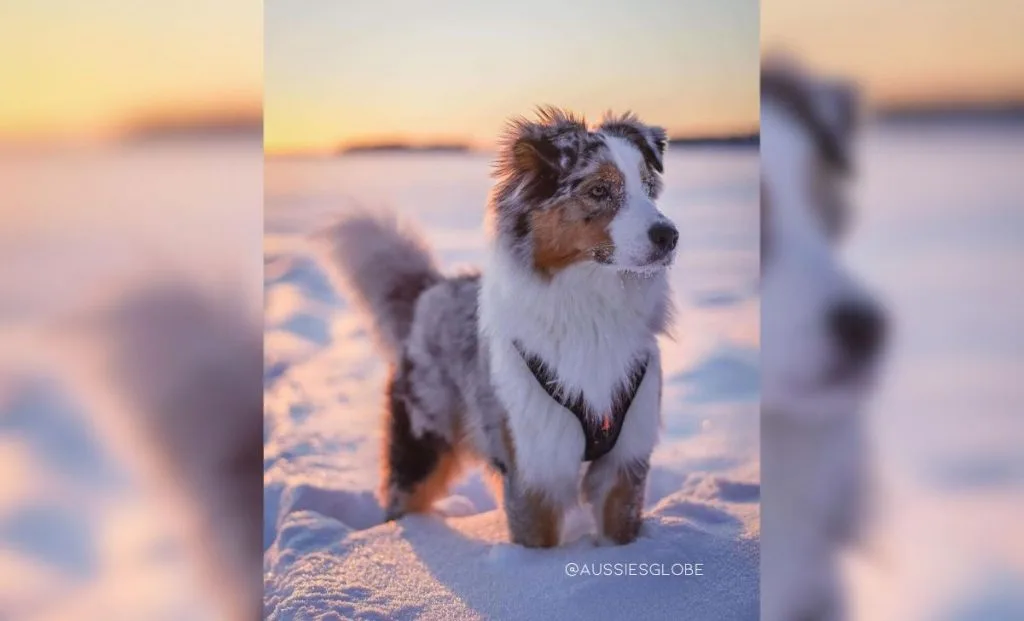
As well as with any dog breed, early socialization and training can help puppies to grow into good dogs that are well behaved regardless of their energy levels. Mini Aussies are highly trainable and eager to please their owner.
With the great potential this breed has, you should think about entering the dog competitions such as agility and obedience. These furry companions are fast learners and will do whatever you wish to teach them.
In their puppy stage, it is important to crate-train your Mini Aussie as they can develop separation anxiety.
Some of the training tips are to use positive reinforcement and some interactive toys. You can help your puppy learn that being left alone for a little bit is not a bad thing. This can also help you teach them not to bark without a cause.
Other than standard training methods, you can enroll them into activities with you, such as jogging, hiking, dock diving, frisbee catching, rollerblading etc.
If you live in the city, it would be great if you could get them on the farm occasionally and let them herd. You will enjoy watching their herding instincts play out and have them go to work even without your command.
Health
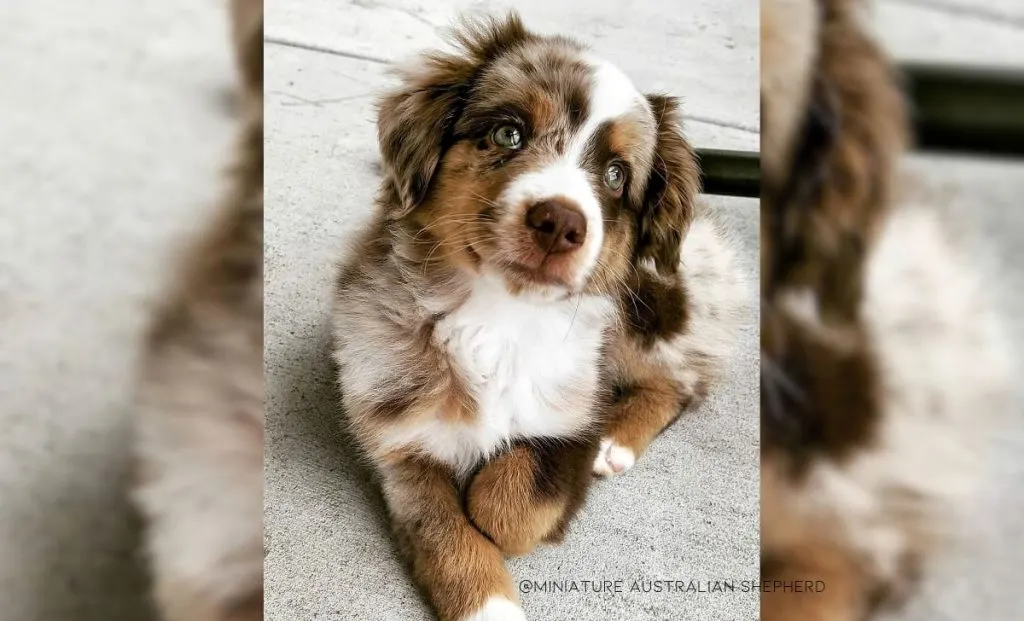
Overall, this is a very healthy breed, and responsible breeders do additional tests for genetic health conditions to make sure affected dogs are not bred. This helps preserve this breed as well as its unique traits as long as possible.
Their life expectancy is projected to be 12 – 13 years. Generally, regardless of the breed you want to purchase (or adopt), getting pet insurance is not a bad idea. It might help you out in the long run when dealing with any health treatments.
Like all dogs, this breed also tends to have a few possible health issues:
- Collie Eye Anomaly
- Hip Dysplasia
- Iris Coloboma
- Cataracts
- Progressive Retinal Atrophy (PRA)
- Luxating Patella
- MDR1 Genetic Mutation
Collie Eye Anomaly
This is an eye disorder that shows up since birth. The structures in the back of the eye do not develop properly. This condition can be detected by a veterinary ophthalmologist through a routine eye check up as early as 6 weeks of age.
Not all dogs who have this anomaly show symptoms, but some of them can go blind. Unfortunately, there is no treatment available for this disease.
Hip Dysplasia
Hip dysplasia is an inherited condition where the hip joint doesn’t properly align. This can cause a strong pain for your dog. It can be developed on one or both joints.
Some Mini Aussies can be born with this condition, although it is rare. More often, it is developed in their senior years. Some of the symptoms are:
- Lameness
- Slower rise from lying position
- Avoiding to run, jump or go up or down the stairs
- Holding up the affected leg, etc.
When purchasing your Mini Aussie, make sure you check for the breeder that has their dogs certified with a PennHIP evaluation. This evaluation will confirm if the dogs that are being bred can pass on this condition to your puppy.
Hip dysplasia can be treated with joint supplements and certain medications, but in severe cases, it may require surgery.
Iris Coloboma
This is one more eye condition represented with a hole in the iris that can be spotted since birth. A coloboma can show up in different sizes.The larger it is, the dog’s eyes will be more sensitive to light. You may notice that your dog is squinting his eyes during the sunny days.
There is no treatment for this, but luckily this condition is not painful and it doesn’t spread to the eye.
Cataracts
Cataracts show up in a form of cloudy lens over the eye of your puppy. Small cataracts can be spotted only with proper medical equipment. Larger ones can be easy to see as the pupil will look as if it is completely white. The larger the cataract, the greater loss of vision.
Miniature Australian Shepherds can develop this condition at a very young age. It is hereditary so the breeder should be aware of this condition in the puppy’s parents.
Good thing is that this can be removed with surgery and bring the sight back to the pup.
Progressive Retinal Atrophy (PRA)
Progressive retinal atrophy is a condition where the eye’s retina slowly degenerates. Unfortunately, over time this condition leads to blindness. This is usually diagnosed in Mini Aussies when they are 3 – 9 years old.
There is no cure for PRA, but with proper care, blind dogs can live a happy life as well.
Luxating Patella
This is a health condition where a dog’s kneecap moves out of place. There are different degrees of kneecap luxation. Severe cases require orthopedic surgery.
Usual symptoms are:
- limping
- cracking or popping sounds when bending the knee
- bow legged stance
Multidrug – Resistant MDR1 Genetic Mutation
Miniature Aussies can carry this mutation in the MDR1 gene. This can cause them to have really severe, sometimes life threatening side effects to certain medications.
It is important to do the testing on this mutation and if affected, advise your vet so that he knows what medication cannot be given to your dog in case of the treatment.
Nutrition

For the first year of their life, it is best to feed them with puppy food that has the essential nutrients and is calorie dense so it can ensure the proper growth and development.
After 12 months, you should slowly transition to adult food for medium breed. The food doesn’t have to be commercial, it can be homemade as well. It should be high quality regardless.
If you decide to feed your dog with homemade food (raw, cooked etc) it would be best if you consult with your vet to ensure that your dog gets all the nutrients from the food it eats.
After 8 years of age, the food should be adjusted again, and you should have your dog transition to a senior dog diet that has nutrients and contains joint support.
Your Mini Aussie should be fed twice a day: once in the morning and once in the evening. You will need to pay attention to the speed your dog eats. If it eats too fast it may cause bloating and digestive issues. If that is the case, buying a slow feeder bowl should solve this issue.
Following the measurement instructions on the packaging of the dog food you use, or the veterinarian’s recommendations, can prevent going overboard with food and causing obesity.
Keep in mind that your dog’s diet throughout the day should be 90% dog food ( two solid meals) and only 10% treats.
It is often suggested that supplements such as fish oil (preferably salmon oil) or omega-3 supplements, as well as multivitamins, be added to your pup. But please ask for veterinary guidance before you give your pup any supplements!
Conclusion
After taking into consideration all the information as well as your own lifestyle, activity level and aspirations, you will know if the Miniature Australian Shepherd is a breed for you.
If you decide to enroll in the life of the adventure without having to worry if your dog will fit your accommodation, you will not regret choosing these little fellas as your companions.
Finally, these dogs don’t require a lot of space, just the one in your heart!
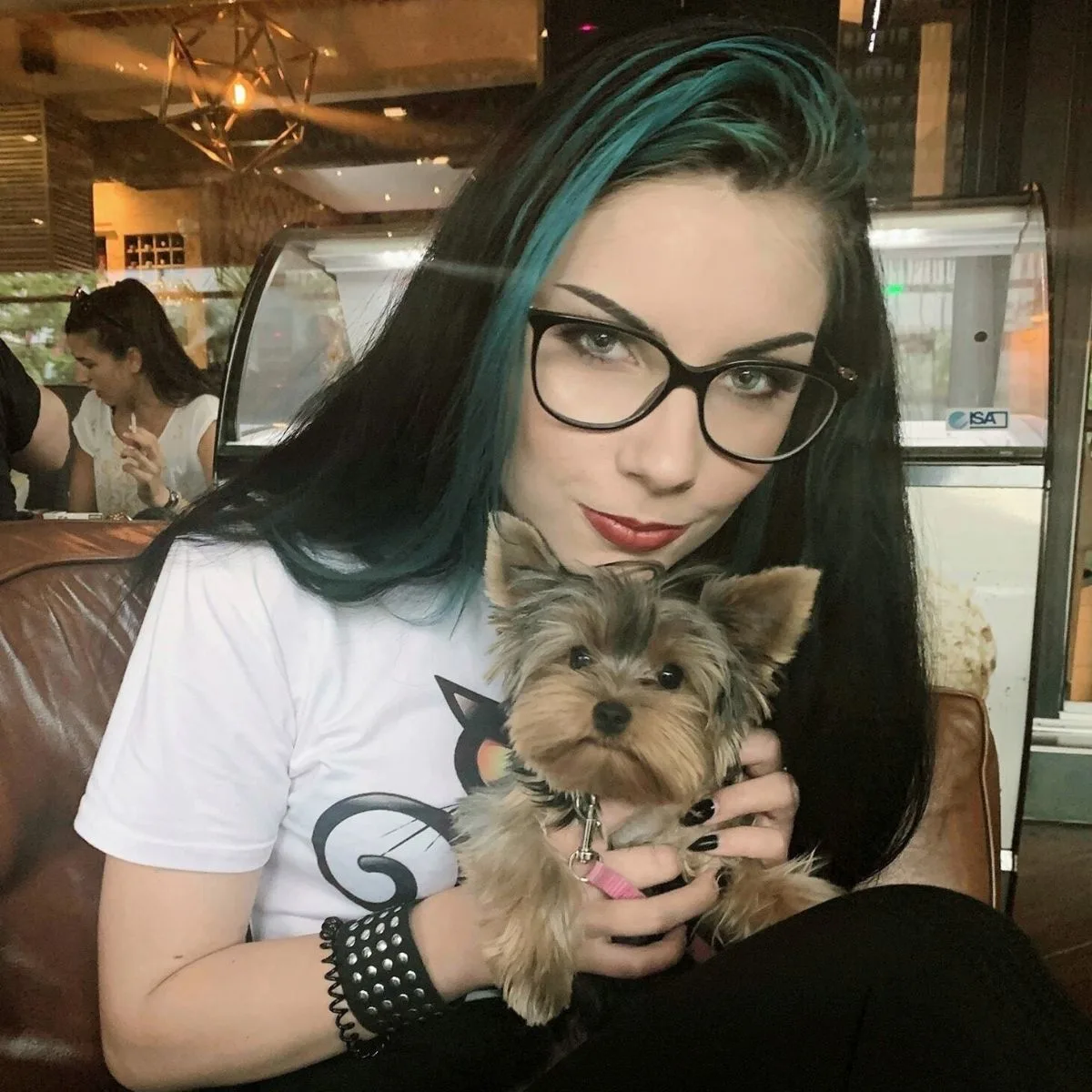
Vanja’s passion for writing started at an early age, which is why she pursued Journalism as her college degree. She can research any topic and find all the information before you bat an eye, which is a great thing for her job but a terrible one for her husband.
Even as a young child, she fell in love with everything fluffy – but dogs have a special place in her heart due to her childhood companion, a Corgie named Archie.
Motivated by her experiences and driven by a desire to give back to her four-legged companions, she spends her free time volunteering at a local dog shelter.
